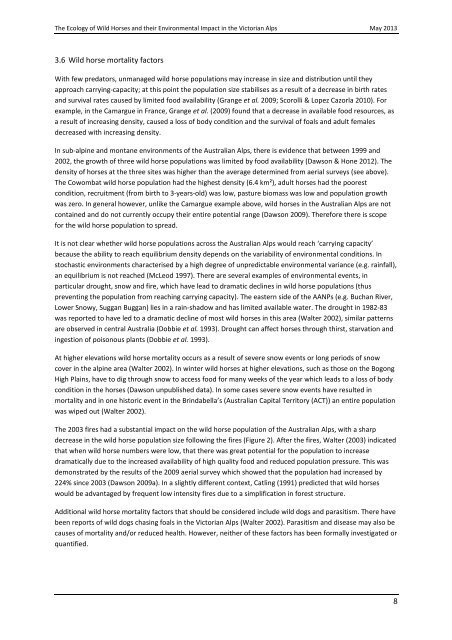The Ecology of Wild Horses and their Environmental ... - Parks Victoria
The Ecology of Wild Horses and their Environmental ... - Parks Victoria
The Ecology of Wild Horses and their Environmental ... - Parks Victoria
You also want an ePaper? Increase the reach of your titles
YUMPU automatically turns print PDFs into web optimized ePapers that Google loves.
<strong>The</strong> <strong>Ecology</strong> <strong>of</strong> <strong>Wild</strong> <strong>Horses</strong> <strong>and</strong> <strong>their</strong> <strong>Environmental</strong> Impact in the <strong>Victoria</strong>n Alps May 20133.6 <strong>Wild</strong> horse mortality factorsWith few predators, unmanaged wild horse populations may increase in size <strong>and</strong> distribution until theyapproach carrying-capacity; at this point the population size stabilises as a result <strong>of</strong> a decrease in birth rates<strong>and</strong> survival rates caused by limited food availability (Grange et al. 2009; Scorolli & Lopez Cazorla 2010). Forexample, in the Camargue in France, Grange et al. (2009) found that a decrease in available food resources, asa result <strong>of</strong> increasing density, caused a loss <strong>of</strong> body condition <strong>and</strong> the survival <strong>of</strong> foals <strong>and</strong> adult femalesdecreased with increasing density.In sub-alpine <strong>and</strong> montane environments <strong>of</strong> the Australian Alps, there is evidence that between 1999 <strong>and</strong>2002, the growth <strong>of</strong> three wild horse populations was limited by food availability (Dawson & Hone 2012). <strong>The</strong>density <strong>of</strong> horses at the three sites was higher than the average determined from aerial surveys (see above).<strong>The</strong> Cowombat wild horse population had the highest density (6.4 km²), adult horses had the poorestcondition, recruitment (from birth to 3-years-old) was low, pasture biomass was low <strong>and</strong> population growthwas zero. In general however, unlike the Camargue example above, wild horses in the Australian Alps are notcontained <strong>and</strong> do not currently occupy <strong>their</strong> entire potential range (Dawson 2009). <strong>The</strong>refore there is scopefor the wild horse population to spread.It is not clear whether wild horse populations across the Australian Alps would reach ‘carrying capacity’because the ability to reach equilibrium density depends on the variability <strong>of</strong> environmental conditions. Instochastic environments characterised by a high degree <strong>of</strong> unpredictable environmental variance (e.g. rainfall),an equilibrium is not reached (McLeod 1997). <strong>The</strong>re are several examples <strong>of</strong> environmental events, inparticular drought, snow <strong>and</strong> fire, which have lead to dramatic declines in wild horse populations (thuspreventing the population from reaching carrying capacity). <strong>The</strong> eastern side <strong>of</strong> the AANPs (e.g. Buchan River,Lower Snowy, Suggan Buggan) lies in a rain-shadow <strong>and</strong> has limited available water. <strong>The</strong> drought in 1982-83was reported to have led to a dramatic decline <strong>of</strong> most wild horses in this area (Walter 2002), similar patternsare observed in central Australia (Dobbie et al. 1993). Drought can affect horses through thirst, starvation <strong>and</strong>ingestion <strong>of</strong> poisonous plants (Dobbie et al. 1993).At higher elevations wild horse mortality occurs as a result <strong>of</strong> severe snow events or long periods <strong>of</strong> snowcover in the alpine area (Walter 2002). In winter wild horses at higher elevations, such as those on the BogongHigh Plains, have to dig through snow to access food for many weeks <strong>of</strong> the year which leads to a loss <strong>of</strong> bodycondition in the horses (Dawson unpublished data). In some cases severe snow events have resulted inmortality <strong>and</strong> in one historic event in the Brindabella’s (Australian Capital Territory (ACT)) an entire populationwas wiped out (Walter 2002).<strong>The</strong> 2003 fires had a substantial impact on the wild horse population <strong>of</strong> the Australian Alps, with a sharpdecrease in the wild horse population size following the fires (Figure 2). After the fires, Walter (2003) indicatedthat when wild horse numbers were low, that there was great potential for the population to increasedramatically due to the increased availability <strong>of</strong> high quality food <strong>and</strong> reduced population pressure. This wasdemonstrated by the results <strong>of</strong> the 2009 aerial survey which showed that the population had increased by224% since 2003 (Dawson 2009a). In a slightly different context, Catling (1991) predicted that wild horseswould be advantaged by frequent low intensity fires due to a simplification in forest structure.Additional wild horse mortality factors that should be considered include wild dogs <strong>and</strong> parasitism. <strong>The</strong>re havebeen reports <strong>of</strong> wild dogs chasing foals in the <strong>Victoria</strong>n Alps (Walter 2002). Parasitism <strong>and</strong> disease may also becauses <strong>of</strong> mortality <strong>and</strong>/or reduced health. However, neither <strong>of</strong> these factors has been formally investigated orquantified.8
















